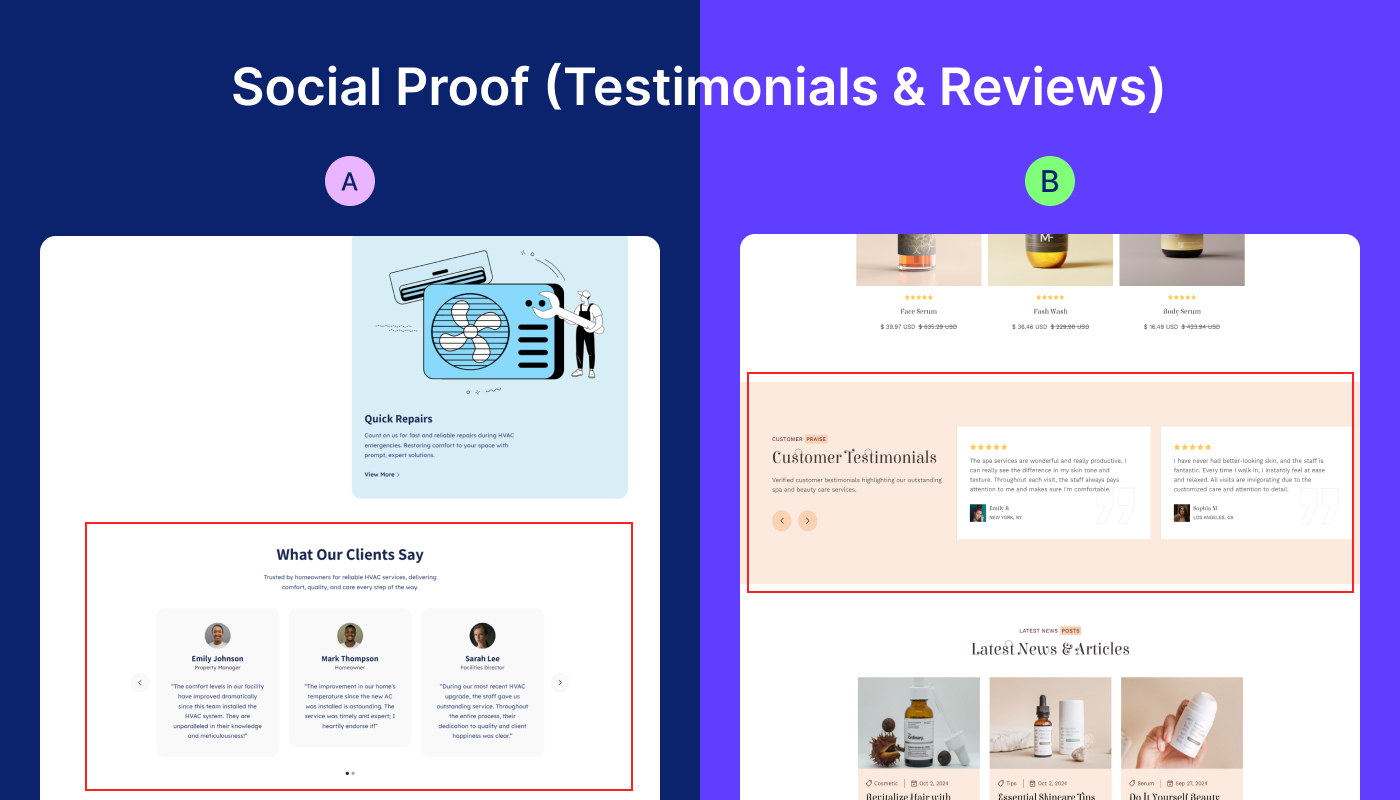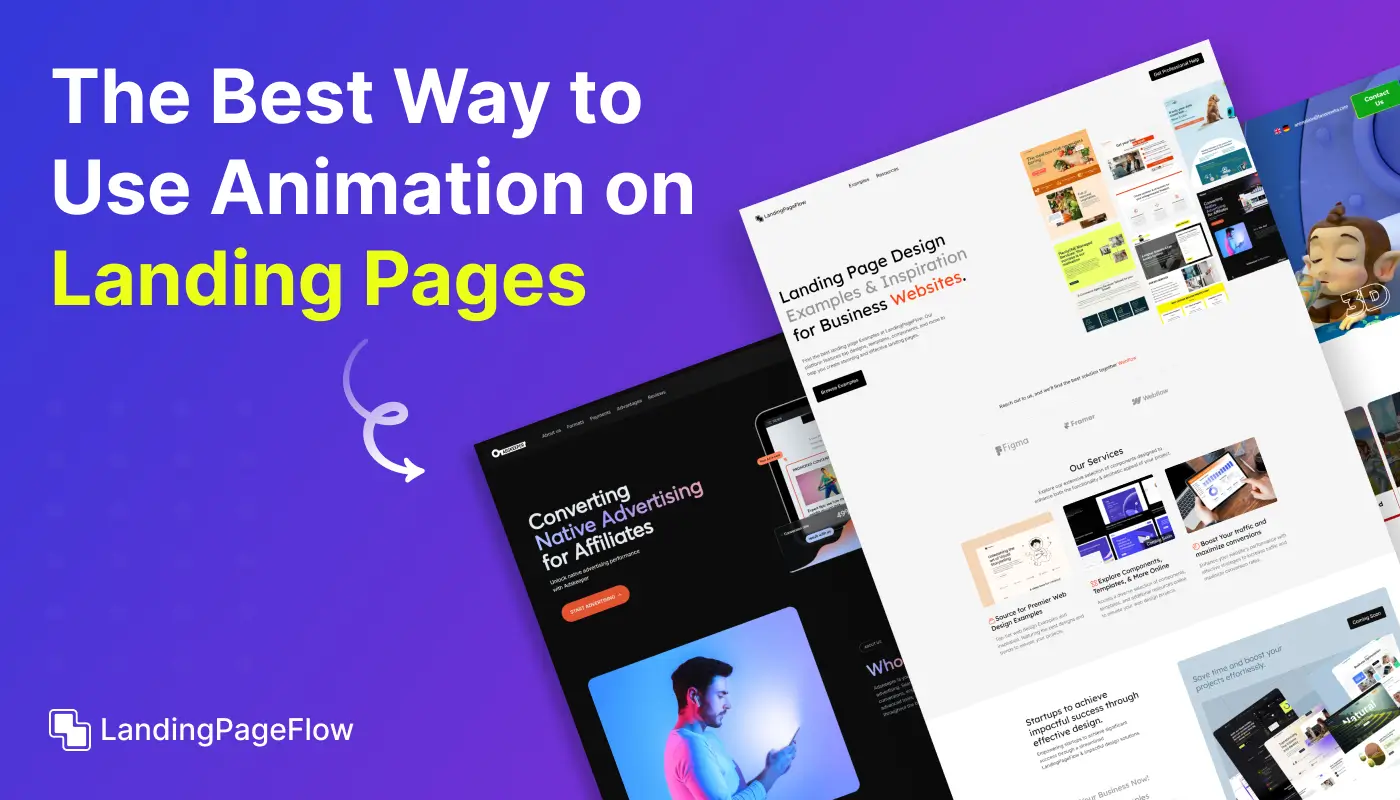Complete Guide For Landing Page A/B Testing Boosts Conversions

November 13, 2025
Digital marketers constantly seek ways to refine their landing pages for better results. A/B testing provides the insights needed to identify what resonates with audiences.
By comparing two versions of a page, businesses discover which design converts more. This process helps optimize calls-to-action, visuals, headlines, and layouts effectively.
Landing page A/B testing allows brands to improve conversion rates and reduce bounce rates. Marketers gain clarity on user behavior, which enhances the overall customer journey.
Testing ensures decisions are backed by data rather than assumptions, boosting ROI. Every successful digital strategy today incorporates A/B testing for sustainable growth.
"Elevate customer engagement through optimized landing page designs.
Secure your free professional review today."
Table of Contents
- What is Landing Page A/B Testing and How Does It Work?
- Why Do We Do A/B Testing?
- Examples of Landing Page A/B Testing Success
- How to Decide What to Test
- How Do You Perform a Landing Page A/B Test in Leadpages?
- Best Practices For A/B Testing Landing Pages
- Mistakes to Avoid When Running Landing Page A/B Tests
- Understanding Statistical Significance in Landing Page A/B Testing
- Time to Put A/B Testing to the Test!
1. What is Landing Page A/B Testing and How Does It Work?

Landing page A/B testing, also called split testing, is the process of comparing two versions of a landing page, Version A (the control) and Version B (the variation), to determine which one drives better performance.
The goal is to identify which version results in higher conversion rates, whether that’s more sign-ups, sales, or other desired actions.
This testing method involves changing just one element at a time so you can clearly see what’s influencing user behavior. It's an essential strategy for marketers and businesses looking to optimize landing page performance using real data.
How A/B Testing Works:
- Create two versions of your landing page: A (original) and B (variant).
- Modify only one element in Version B to test its impact.
- Split your web traffic equally between the two versions.
- Monitor key metrics like click-through rate, bounce rate, and conversions.
- Choose the version that performs better and apply the winning change.
Common Elements You Can Test:
- Headline – Try different messaging to see what captures attention best.
- CTA Buttons – Experiment with different colors, texts, and placements.
- Images or Videos – Swap visuals to see which ones connect more with visitors.
- Form Lengths – Test shorter vs. longer forms to improve form submissions.
- Content Structure – Change the order or placement of content blocks.
Benefits of A/B Testing Your Landing Pages:
- Make data-driven improvements instead of guessing what works.
- Increase conversions by identifying what resonates with your audience.
- Enhance user experience by testing layout, copy, and design choices.
- Reduce bounce rates and improve overall site performance.
2. Why Do We Do A/B Testing?

A/B testing offers numerous benefits, such as:
Enhanced User Experience
A/B testing allows you to fine-tune your landing page based on real user feedback, ensuring a more seamless experience.
Low-Risk, High Reward
Small adjustments, like changing a headline or adjusting button placement, can have a huge impact on conversion rates without major risk.
Understand Your Audience Better
Testing gives you direct insight into what resonates with your visitors, leading to improved targeting and personalization.
Lower Bounce Rates
Optimized landing pages reduce bounce rates by making content more relevant and appealing.
Increase Conversion Rates
Through iterative testing, you can discover the combination of elements that converts best.
More Revenue
Better conversions mean more sales or leads, directly translating to higher revenue.
3. Examples of Landing Page A/B Testing Success
Here are some real-world examples of successful A/B testing outcomes:

+28% conversions by removing the CTA: Sometimes, a minimalist approach can outperform a cluttered one.

+28% conversions by adding a progress bar: Progress bars can guide users and boost engagement.

+34.43% conversions by using the right product image: The visual impact of images can drive greater interest and conversions.

+75% conversions by changing an image: Even minor image changes can make a huge difference.

+307% conversions by using the right headline: Headlines are critical in capturing attention and driving action.
4. How to Decide What to Test on a Landing Page
When planning your landing page A/B testing strategy, it’s essential to focus on elements that directly influence conversion rates.
Every component on your landing page contributes to how users behave, whether they stay, click, sign up, or leave. That’s why you should start by identifying high-impact areas that can yield measurable improvements.
Below are the most important elements to test during A/B testing for landing pages, along with what to consider for each.
1. Headline

Your landing page headline is the first thing visitors see, and often the deciding factor in whether they stay or bounce. It needs to be clear, benefit-driven, and aligned with user intent. Test variations that emphasize different angles: emotional triggers, pain points, questions, or direct value propositions.
Example tests:
- Problem-focused vs. benefit-focused headlines
- Long-form vs. short, punchy headlines
- Including numbers/statistics vs. abstract phrasing
2. Copy (Body Text)

The body copy should guide users smoothly from your headline to the call-to-action. Effective copywriting addresses objections, highlights benefits, and builds trust. Small tweaks, like tone, length, formatting, or word choice, can make a big impact.
Example tests:
- Short vs. detailed descriptions
- Formal vs. conversational tone
- Bullet points vs. paragraphs
3. Images

Visuals play a critical role in building emotional connection and influencing decision-making. Testing different images helps determine which visuals best support your offer. This includes product shots, hero banners, lifestyle images, or even removing unnecessary visuals.
Example tests:
- Real people vs. illustrations
- Product in use vs. static image
- Brighter vs. muted color palettes
4. Opt-in Forms

Your lead generation form is often the conversion point, whether for a newsletter, product demo, or free trial. Changes in form design or content can drastically affect user submissions.
Example tests:
- Number of fields (e.g., name + email vs. full form)
- Form layout (horizontal vs. vertical)
- Placeholder text or microcopy tweaks
5. CTA (Call-to-Action) Buttons

The CTA button is arguably the most tested element, and for good reason. Button copy, color, placement, and size all play a role in convincing users to take action. A small change here can lead to a big lift in conversions.
Example tests:
- “Get Started” vs “Try It Free”
- Red button vs. green button
- Button above the fold vs. below the fold
6. Countdown Timers

Countdown timers create a sense of urgency and can encourage quicker decisions. But they don’t work in every context.
Test different timer designs, placements, or even removing them to see what builds the most urgency without overwhelming users.
Example tests:
- Static vs. dynamic timers
- Timer at the top vs. near CTA
- Visible timer vs. hidden until scroll
7. Social Proof (Testimonials & Reviews)

Testimonials, ratings, logos, and user reviews build trust with potential customers. A/B test how and where you display social proof; sometimes, less is more, and strategic placement can boost impact.
Example tests:
- Text testimonial vs. video testimonial
- Review placement near CTA vs. at the bottom
- Number of reviews shown
8. Price Points

If your landing page includes pricing, testing different price anchors or presentation formats can have a dramatic effect. Even how you frame pricing, monthly vs. yearly, discount vs. full price, can influence user perception.
Example tests:`
- Single pricing plan vs. tiered plans
- “As low as $10/month” vs “$120/year”
- Price with or without a strikethrough
9. Page Length and Layout

Some users prefer a quick overview; others want a deep dive. Testing short-form vs. long-form landing pages helps you understand how much information your visitors need before converting. Layout structure, including whitespace, section order, and visual flow, can also affect engagement.
Example tests:
- Full-scroll landing page vs. compact layout
- Above-the-fold CTA vs. end-of-page CTA
- Section reordering (e.g., moving testimonials up)
5. How Do You Perform a Landing Page A/B Test in Leadpages?

Leadpages simplifies A/B testing by providing an intuitive platform to create and test landing page variations. Here’s a step-by-step guide:
- Choose Your Landing Page: Select the landing page you want to test.
- Create a Variant: Make one change to your page (e.g., modify the CTA button or headline).
- Split Your Traffic: Direct half of your traffic to the original version and half to the variant.
- Analyze Results: Use Leadpages’ built-in analytics tools to compare performance and determine the winning version.
6. Best Practices For A/B Testing Landing Pages

To make your A/B testing efforts more effective, follow these best practices:
- Test One Variable at a Time: To ensure accurate results, change only one element at a time.
- Let Your Test Run Long Enough: Don’t rush; let the test run for enough time to gather statistically significant data.
- Segment and Personalize When Possible: Tailor your tests to different user segments to get more actionable insights.
- Measure More Than Just Clicks: Track other metrics like time on page, bounce rate, and form completions.
- Don’t Guess, Keep Testing: Even after you find a winner, continue testing new variations to keep improving.
7. Mistakes to Avoid When Running Landing Page A/B Tests

Here are some common mistakes to steer clear of:
- Failing to account for past results: Don’t disregard previous tests when designing new ones.
- Testing the wrong page: Make sure you’re testing a page that directly impacts your business goals.
- Changing variables mid-test: Once your test is running, avoid making changes to the variables; this can skew your results.
8. Understanding Statistical Significance in Landing Page A/B Testing
What Is Statistical Significance (And Why It Matters)?
Statistical significance ensures that your test results are not due to random chance. It’s crucial for determining whether one variation truly outperforms the other.
Set Your Confidence Level
The most common confidence level is 95%, meaning you can be 95% sure that your results are not random.
How Do You Know If Your Test Is Significant?
Monitor the results until the test has enough data to show a clear winner, and look for a p-value less than 0.05.
Pro Tip: Avoid “Peeking”
It’s tempting to check test results early, but doing so can lead to incorrect conclusions. Always wait for the test to run its full course.
9. Time to Put A/B Testing to the Test!

Now that you’re equipped with the strategies, tools, and insights to optimize your landing pages, it’s time to take action.
A/B testing isn’t just a one-time tactic, it’s a continuous learning process that helps you understand what truly resonates with your audience.
Whether you're tweaking headlines, testing CTA colors, or experimenting with layout changes, every test brings you one step closer to higher conversions and better ROI.
Start with one variable, let the data guide your decisions, and don’t be afraid to iterate. Use platforms like Leadpages to make testing simple, track performance, and scale your efforts.
Over time, these small, data-backed improvements compound into significant results for your business.
Remember: the most successful marketers aren't just creative, they're curious, data-driven, and always testing. So take what you’ve learned here, run your first experiment, and let real insights shape your landing page strategy.
Conclusion
Landing page A/B testing remains a cornerstone of effective digital marketing strategies. Companies that prioritize testing gain valuable insights into customer behavior.
Higher conversions often result from small yet impactful design or copy adjustments. SEO-optimized landing pages paired with A/B testing can deliver measurable growth.
Engagement improves as visitors experience streamlined and user-friendly pages. Data-driven decisions ensure long-term success across campaigns and industries.
Businesses leveraging A/B testing enjoy stronger ROI and competitive advantage.

FAQ
1. What is landing page A/B testing?
It is the process of creating two versions of a landing page to test which one performs better in driving conversions and user engagement.
2. Why is A/B testing important for landing pages?
A/B testing identifies elements that resonate most with visitors, helping improve conversion rates, reduce bounce rates, and increase ROI.
3. Which landing page elements should be A/B tested?
Headlines, CTAs, images, layouts, forms, and button placements are common elements tested for performance improvements.
4. How long should an A/B test run?
A test should run until there is statistically significant data, often two to four weeks depending on traffic volume.
5. Can A/B testing improve SEO results?
Yes, by optimizing landing page experience and reducing bounce rates, A/B testing indirectly supports stronger SEO performance.
6. What tools are best for landing page A/B testing?
Tools like Google Optimize, Optimizely, Unbounce, and VWO are widely used for effective A/B testing of landing pages.



















